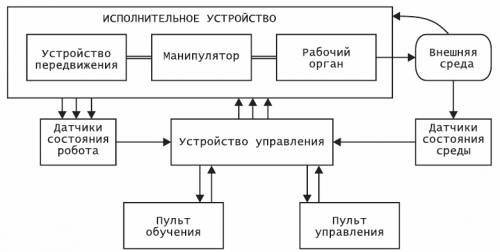Robots and robotic devices — terms and definitions
Robot: An executive device with two or more programmable degrees of mobility, having a certain level of autonomy and capable of moving in the external environment to perform assigned tasks.
Robotic device: An executive device that has the properties of an industrial or service robot, but that does not have the required number of programmable degrees of motion or a certain level of autonomy.
GOST R 60.0.3.1-2016 Robots and robotic devices. Types of tests
Robot: A drive mechanism, programmable in two or more axes, with a certain degree of autonomy, moving in its working environment and performing the tasks as intended.
NOTE 1 The robot includes a control system and a control system interface.
NOTE 2 The division of robots into industrial robots and service robots is done in accordance with their purpose.
Robotic device: Actuator with characteristics of an industrial robot or a service robot. It may have non-programmable axes or insufficient autonomy.
EXAMPLE Amplifier; remote control device; two-axis industrial manipulator.
Industrial robot: An automatically controlled, reprogrammable, multi-function manipulator, programmable in three or more axes. It can either be fixed at a predetermined location or it can be mobile to perform industrial automation tasks.
Note 1 — An industrial robot includes: — a manipulator, including actuators; — controller including pendant for pendant and communication interface (electronics and software).
NOTE 2: This object may have additional integrated axes.
Robotic system: A system that includes robots, working parts of robots, as well as machines, equipment, devices and sensors that support robots during operation.
Industrial robotic system: A system that includes industrial robots, working bodies, machines, equipment, devices, external auxiliary axes and sensors that support the robots during operation.
GOST R ISO 8373-2014 Robots and robotic devices. Terms and definitions
Industrial robot
An automatic machine, stationary or mobile, consisting of an executive device in the form of a manipulator with several degrees of mobility and a reprogrammable program control device to perform motor and control functions in the production process.
Note: Reprogramming is the property of an industrial robot to replace a control program automatically or with the help of a human operator.Reprogramming involves changing the sequence and (or) values of displacements by degree of mobility and control functions using the controls of the remote control of the control device.
GOST 25686-85. Manipulators, car operators and industrial robots. Terms and Definitions (Amendment No. 1)

Robotics is a branch of fundamental and applied science that deals with the design, production and application of automatic and automated technical systems — robots. A robot is a specially designed, reprogrammable mechanical device that can operate without human assistance.
Justin J. Beyond BASIC Face-off // PC Tech Journal. — 1987, September. — P. 136. — (Translated by B.H. Lopukhov).
Infographic Robots:
When it appeared in modern robotics, a robot was defined as an automatic machine for performing mechanical actions similar to those performed by a human doing physical work. It was the desire to replace a person, above all, in difficult and dangerous jobs that gave birth to the idea of a robot. In modern robotics, however, the definition of a robot must be greatly expanded, as robots have exceeded the general dimensions of a human. The subject of modern robotics is the technical analogues of objects from the entire living world, including, of course, people.
Yurevich E. I. Fundamentals of robotics: a survey. allowance. — 4th edition, revised. and add — SPb.: BHV-Petersburg, 2018.
The term «robot» is of Slavic origin. It was introduced by the famous writer Karel Čapek in the play «R.U.R.» (Rossum Universal Robots). This word is named after mechanical robots designed to replace humans in hard physical work.The technical term «industrial robot» appeared in the 70s of the XX century. However, we can assume that the roots of robotics go back to ancient times, when the first attempts were made to create humanoid devices, movable cult figures, mechanical servants.
A robot is a technical complex designed to perform various movements and some intellectual functions inherent in humans. The robot is equipped with the necessary executive devices, control and information systems, as well as tools for solving computational and logical tasks. The main components of a robot are a manipulation mechanism and an automatic control system that includes a microcomputer or a set of microprocessors, and in some cases also includes a sensor device.
Structural diagram of an industrial robot:
Bulgakov A. G., Vorobiev V. A. Industrial robots. Kinematics, dynamics, control and management. Engineering Library Series. — M.: SOLON-PRESS, 2008.
 Analogy between the processes of reception, processing and transformation of signals in biological and technical systems (human and robot)
Analogy between the processes of reception, processing and transformation of signals in biological and technical systems (human and robot)
The laws of robotics
1. A robot may not harm a person or, through its inaction, allow a person to be harmed.
2. A robot must obey all orders given by a person, except where those orders conflict with the First Law.
3. The robot must take care of its safety to the extent that this does not contradict the First and Second Laws.
Isaac Asimov, 1965
Articles on this topic:




